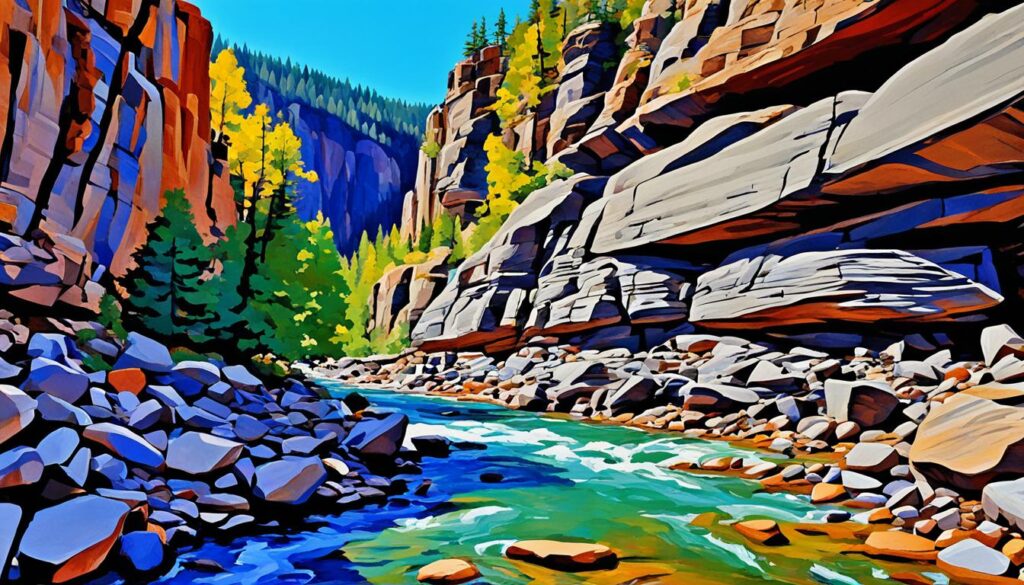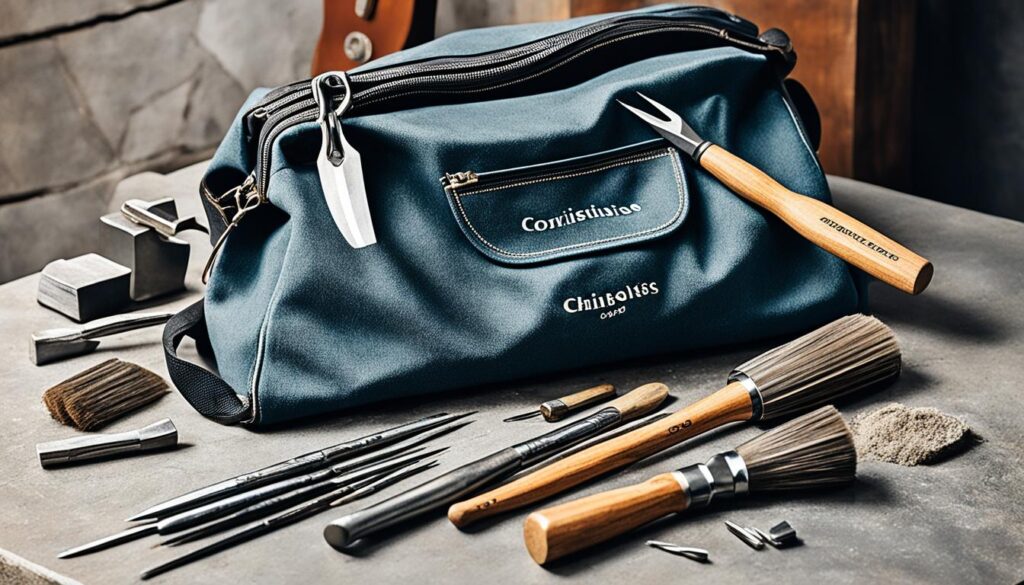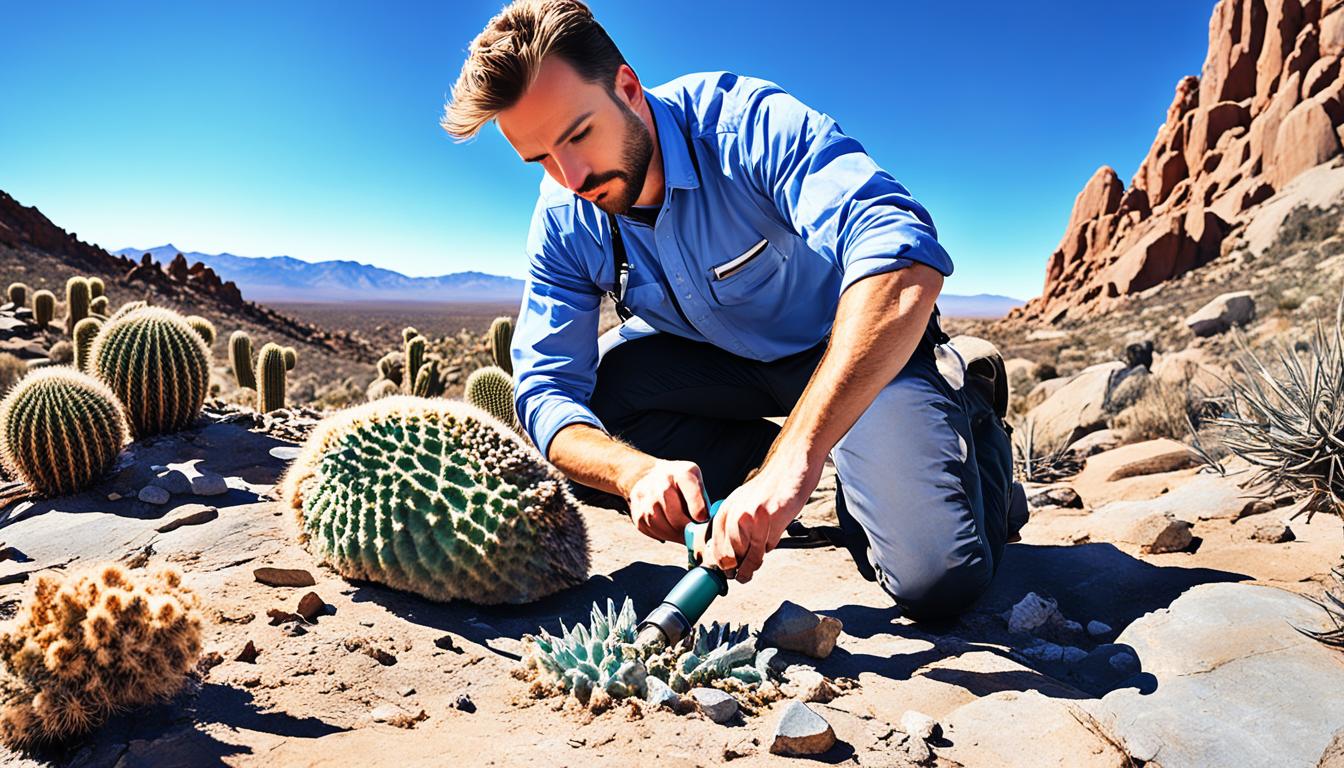This post contains affiliate links.
Do you remember the thrill of finding a hidden treasure as a child? The excitement that rushed through your veins as you stumbled upon a shiny rock or a sparkling gem? It’s a feeling that never truly fades. And that’s why rock hounding, also known as amateur geology, continues to captivate people of all ages.
Rock hounding is more than just a hobby—it’s a journey of exploration, a way to connect with the Earth’s history, and a chance to uncover the beauty that lies beneath the surface. Whether you’re intrigued by the allure of minerals, the fascination of fossils, or the enchantment of gems, rock hounding offers endless adventures and discoveries.
Imagine roaming through rugged landscapes, scouring rocky outcrops, and sifting through gravel in search of hidden treasures. Each find holds the potential to unveil the secrets of the past, to shed light on the incredible forces that shaped our planet.
Are you ready to embark on your own rock hounding journey? In this article, we’ll guide you through the basics of rock hounding, equip you with essential knowledge, and share valuable tips to help you get started on this exciting adventure. Get ready to unleash your inner explorer!
Key Takeaways:
- Rock hounding, also known as amateur geology, is the recreational study and collecting of rocks, gems, minerals, and fossils from their natural environment.
- Rock hounding offers a thrilling adventure that allows you to reconnect with the Earth’s history and uncover hidden treasures.
- Exploring remote locations, utilizing essential tools, and learning how to identify rocks and minerals are essential aspects of rock hounding.
- The United States boasts numerous rock hounding sites, each with its own unique specimens waiting to be discovered.
- Respecting rules, practicing good etiquette, and prioritizing safety are crucial for a successful and enjoyable rock hounding trip.
What is Rock Hounding?
Rock hounding is like a treasure hunt in nature, where you get to be both an explorer and a collector. It’s the thrilling recreational activity of searching for rocks, gems, minerals, and fossils in their natural habitats. Think of yourself as a modern-day adventurer delving into the secrets of the Earth. With rock hounding, you can indulge your curiosity, learn about amateur geology, and build an impressive collection of captivating specimens.
As a rock hounding enthusiast, you’ll venture into remote locations filled with geological wonders. Picture yourself standing on the edge of a cliff, sifting through gravel on a streambank, or carefully examining a roadcut. These hidden corners of the world hold a treasure trove of rocks and minerals just waiting to be discovered.
Rock hounding is not just about the hunt; it’s also a gateway to understanding the Earth’s geological history. With each find, you’ll uncover fascinating insights into ancient landscapes, past environments, and the forces that shaped our planet. And let’s not forget the sheer beauty and diversity of rocks and minerals, with their vibrant colors, intricate patterns, and mesmerizing formations.
Whether you embark on this adventure alone or join forces with fellow enthusiasts, rock hounding offers an unforgettable experience. It’s a chance to escape the hustle and bustle of everyday life, immerse yourself in nature, and embark on a journey of awe-inspiring exploration.
Where to Start?
Now that you’re ready to embark on your rock hounding adventure, the first step is to gather information about potential locations. Don’t worry, you won’t have to dig through mountains of data. There are several handy resources that can point you in the right direction.
Let’s start with field guides. These invaluable references provide detailed information about specific rock hounding locations and the types of specimens you can expect to find. With a field guide in hand, you’ll have the inside scoop on where to go and what you might encounter.
But don’t stop there! Magazines focused on rock hounding are a treasure trove of knowledge. They offer articles, reports, and even personal accounts from experienced rock hounds who’ve scoured countless locations. You’ll find not only helpful tips but also inspiring stories that’ll get you even more excited to hit the rock hounding trail.
If you prefer to stay up to date with the latest information, online databases like Mindat.org are at your service. These comprehensive resources provide a wealth of information about minerals and their corresponding locations. You’ll have the virtual key to unlock new rock hounding opportunities just a few clicks away.
And let’s not forget about local mineral clubs. These communities of like-minded enthusiasts are a fantastic resource for connecting with experienced rock hounds who are more than happy to share their favorite collecting spots. Joining a mineral club opens up a world of rock hounding wisdom, tips, and possibly even some lifelong friendships.

With knowledge from field guides, insights from magazines, data from online databases, and connections from local mineral clubs, you’ll have all the cards stacked in your favor. Armed with this information, you can plan your rock hounding trips more effectively and increase your chances of finding those stunning specimens that will make your collection shine.
Essential Tools for Rock Hounding
To engage in rock hounding, you’ll need the right tools to collect specimens and uncover hidden treasures. Here are the essential tools every rock hound should have in their kit:
1. Rock Hammer or Rock Pick
A rock hammer or rock pick is a must-have tool for chipping away at rocks and breaking them open to reveal their hidden beauty. It’s like having a mini excavation tool in your hand.
2. Sieve or Colander
A sieve or colander is essential for sifting through dirt and debris, separating the valuable rocks and minerals from the unwanted material. It helps you refine your search and saves you time.
3. Trowel or Small Knife
For precise work and delicate excavation, a trowel or small knife is indispensable. It allows you to carefully extract specimens without causing damage and ensures you don’t miss any hidden gems.
4. Chisels of Various Sizes
Chisels are valuable tools for removing specimens from hard matrixes. Having chisels of different sizes in your toolkit gives you the flexibility to tackle various rock formations and extract specimens with precision.
5. Gloves
Protecting your hands is crucial when rock hounding. Gloves shield your skin from rough surfaces, sharp edges, and exposure to dirt and chemicals. Opt for durable gloves that fit well and offer adequate grip.
6. Small Broom or Paintbrush
After extracting a specimen, you’ll want to clean it and remove any loose debris. A small broom or paintbrush is perfect for gently brushing away excess dirt and dust, revealing the true beauty of your find.
| Optional Tools | Description |
|---|---|
| Spray Bottle | A spray bottle filled with water can be handy for cleaning specimens in the field, restoring their natural shine. |
| Pry Bar | A pry bar can come in handy when you encounter large rocks that need to be moved or lifted. |
| Shovel | For digging deeper or excavating in rocky terrains, a sturdy shovel is a valuable tool to have. |
| Stone Polisher or Rock Tumbler | If you want to enhance the appearance of your finds, a stone polisher or rock tumbler can transform rough rocks into polished gems. |
Having these essential tools in your rock hounding arsenal will ensure you’re well-prepared to embark on your next rock hounding adventure and increase your chances of unearthing extraordinary specimens.

Best Sites in the U.S. for Rock Hounding
When it comes to rock hounding, the United States is a treasure trove of incredible sites just waiting to be explored. From dazzling diamonds to captivating fossils, there’s something for every rock hound enthusiast. Here are some of the best sites in the U.S. that should be on your rock hounding bucket list:
Crater of Diamonds State Park, Arkansas: This one-of-a-kind park allows visitors to search for diamonds and other precious gemstones. It’s the only diamond mine in the world where you can keep what you find, making it a truly unique experience.
Gold Prospecting Adventure, California: Channel your inner prospector and try your luck at finding gold. Whether you’re panning for flakes or using a sluice box, the thrill of striking gold is sure to get your heart racing.
Emerald Hollow Mine, North Carolina: Visit the only emerald mine open to the public in the U.S. and uncover beautiful emeralds and other gemstones. With guided tours and the opportunity to dig for your own treasures, this mine is a must-visit for gem enthusiasts.
Fossil Butte National Monument, Wyoming: Step back millions of years into the fossil-rich past at this national monument. Discover beautifully preserved fish, plants, insects, and other fossils that offer a glimpse into Earth’s ancient history.
Juniper Ridge Opal Mine, Oregon: Known for its fiery opals, this mine is a rock hound’s dream come true. Uncover stunning opals in various colors and sizes, and marvel at their captivating play of light.
Morefield Mine, Virginia: Explore this mine, famous for its Amazonite crystals and other minerals. With over 400 different mineral species waiting to be discovered, Morefield Mine is a true paradise for rock enthusiasts.
Herkimer Diamond Mines, New York: Don’t let the name fool you – these quartz crystals may not be diamonds, but they’re just as dazzling. Hunt for these unique and beautiful crystals that resemble diamonds and add them to your collection.
Utah Tiffany Stone: Found exclusively in Utah, this stunning gemstone, composed primarily of purple fluorite, is a prized find for any collector. Its vibrant colors and distinctive patterns make it a true rock hound’s delight.
These are just a few examples of the amazing rock hounding sites across the U.S. Each site offers its own geological wonders, providing a unique experience for rock hounds of all levels. So grab your tools and embark on a rock hounding adventure like no other!
Rock Hounding Rules and Etiquette
When it comes to rock hounding, following the rules and practicing good etiquette is essential for a positive experience. Whether you’re exploring public land, accessing private property, or visiting paid dig sites, it’s important to respect the hobby and the environment. Here are some guidelines to keep in mind:
1. Collecting on Public Land
You’ll find plenty of opportunities to rock hound on public land, but be aware of any restrictions that may apply to National Monuments or National Parks. The Bureau of Land Management provides guidelines on the types of specimens you can collect and limits on quantities. Remember, selling materials collected from public lands is considered bad etiquette.
2. Accessing Private Land
If you want to explore private land for rock hounding purposes, always seek permission from the owner first. Respect their property and follow any guidelines they provide. Trespassing is not only illegal but also disrespectful to the landowner and other rock hounders.
3. Paid Dig Sites
Paid dig sites offer a unique opportunity to access specific rock hounding locations for a fee. When visiting these sites, make sure to adhere to their specific rules and regulations. This ensures a positive experience for all visitors and helps maintain the integrity of the site.
4. Leave No Trace
One of the most important aspects of rock hounding etiquette is to leave the environment as you found it. Avoid causing any damage to the land or disrupting natural habitats. Clean up after yourself and pick up any litter you come across. It’s also crucial to properly extinguish any fires and minimize your impact on the surroundings.
“Respect the hobby, respect the land, and respect fellow rock hounders. Good etiquette ensures the preservation of rock hounding sites for future generations to enjoy.”
By following these rules and practicing good etiquette, you’ll not only contribute to preserving the natural beauty of rock hounding locations but also create a more enjoyable experience for yourself and others. Remember, rock hounding is a shared passion that allows us to connect with the Earth and discover its hidden treasures. Let’s treasure it together!
How to Identify Rocks and Minerals
Identifying rocks and minerals is an exciting part of the rock hounding journey. There are various methods and tools you can use to determine the composition and characteristics of different specimens. Here are some techniques to help you identify rocks and minerals:
- The Scratch Test: This is a simple and effective method where you use a known stone to scratch the surface of another material. By comparing the scratch left behind with the Mohs scale of hardness, you can estimate the hardness of the material and narrow down possible mineral identifications.
- The Mohs Scale: Developed by Friedrich Mohs, this scale ranks minerals on a scale from 1 to 10 based on their hardness. For example, talc has a hardness of 1, while diamond has a hardness of 10. By determining the hardness of a specimen and comparing it to the scale, you can identify potential minerals present.
- Magnetic Properties: Some rocks and minerals contain iron-bearing minerals that exhibit magnetic properties. By using a magnet, you can check if a specimen is attracted to it, indicating the presence of iron-bearing minerals.
- Local Field Guides: Field guides specific to your local area are invaluable resources for identifying rocks and minerals. They provide detailed information about the characteristics, colors, crystal structures, and properties of different specimens found in your region. Consult these guides to enhance your knowledge and narrow down possible identifications.
- Magnifying Glass or Loupe: Examining specimens closely with a magnifying glass or loupe allows you to observe their unique features and details. This can help you identify specific patterns, crystal structures, or inclusions that are characteristic of certain minerals.
By utilizing these tools and references, you can enhance your knowledge of rocks and minerals and confidently identify the specimens you collect during your rock hounding adventures.
| Method | Description |
|---|---|
| The Scratch Test | A simple test using a known stone to scratch the surface of a material and compare the scratch to the Mohs scale of hardness. |
| The Mohs Scale | A scale ranking minerals from 1 to 10 based on their hardness, helping to identify minerals based on their relative hardness. |
| Magnetic Properties | Using a magnet to check if a rock or mineral contains iron-bearing minerals, which exhibit magnetic properties. |
| Local Field Guides | Resources specific to your region that provide detailed information about the characteristics and properties of rocks and minerals. |
| Magnifying Glass or Loupe | Examining specimens closely to observe unique features, crystal structures, and inclusions using a magnifying glass or loupe. |
With these identification methods at your disposal, you’ll be able to uncover the secrets and stories hidden within the rocks and minerals you discover during your rock hounding expeditions.
Tips for a Successful Rock Hounding Trip
Planning a rock hounding trip? Get ready for an exhilarating adventure in nature! To make your expedition a successful one, follow these essential tips:
1. Do Your Research:
Before embarking on your rock hounding journey, research the location thoroughly. Find out about the types of rocks, minerals, and gems you can expect to find. Look for online resources, field guides, and local mineral clubs to gather valuable information about the area.
2. Prepare in Advance:
Proper preparation is key to a successful trip. Make sure you understand the rules and regulations of the specific location you’re visiting. Check if you need any permits or permissions. Pack all the necessary equipment, including safety gear like goggles, gloves, and a hard hat if required.
3. Navigate with Confidence:
Don’t get lost in the excitement of rock hounding! Carry a navigation tool such as a compass and a topographic map to ensure you can find your way to and from the site. Familiarize yourself with the terrain and plan your route accordingly.
4. Prioritize Safety:
Stay safe during your rock hounding trip by taking necessary precautions. Wear appropriate footwear to protect your feet. Apply sun protection and pack extra clothes in case of changing weather conditions. Bring plenty of water and snacks to stay hydrated and energized throughout the day.
5. Respect the Environment:
“Leave no trace.” – Anonymous
As a responsible rock hound, it is crucial to leave the environment as you found it. Respect private property and obtain permission before collecting. Dispose of trash properly and extinguish any fires completely. By practicing good etiquette, you help preserve the natural beauty of rock hounding locations for future generations.
| Essentials for a Successful Rock Hounding Trip: |
|---|
| Goggles |
| Gloves |
| Hard hat (if required) |
| Compass |
| Topographic map |
| Appropriate footwear |
| Sun protection |
| Extra clothes |
| Water and snacks |
By following these tips, you’re well-equipped to have a successful rock hounding trip. Remember, research, preparation, safety, navigation, and comfort are the keys to a memorable adventure!
Conclusion
Rock hounding is more than just a hobby, it’s an exhilarating journey through the geological wonders of our planet. The thrill of exploring and collecting unique specimens is unmatched, making rock hounding a favorite pastime for enthusiasts of all levels. Whether you’re just starting out or have years of experience, the joy of finding that remarkable rock or gem never fades.
To make the most of your rock hounding adventures, acquiring knowledge is key. Study field guides, join mineral clubs, and explore online databases to discover the best locations and learn about the rocks and minerals they offer. With the right tools in hand, such as a rock hammer and sieve, you’ll be equipped to extract and examine specimens with precision and care.
As you venture into the world of rock hounding, remember to practice good etiquette. Respect the environment, follow the rules and regulations of each location, and obtain permissions when necessary. By doing so, you’ll help preserve these natural wonders for future generations, while also ensuring a positive experience for fellow rock hounds.
So, are you ready to embark on your rock hounding journey? Grab your gear, head to a rock hounding site, and let the exploration begin. Uncover the Earth’s hidden treasures and expand your collection – a world of fascinating rocks and minerals is waiting to be discovered!
FAQ
What is rock hounding?
Where can I start with rock hounding?
What tools do I need for rock hounding?
What are some of the best rock hounding sites in the U.S.?
Are there any rules and etiquette for rock hounding?
How do I identify rocks and minerals?
What are some tips for a successful rock hounding trip?
What is rock hounding all about?
Source Links
- https://wheretofindrocks.com/rockhounding-101-how-to-really-find-minerals-and-rocks/
- https://interestingengineering.com/culture/rockhounding-101-bring-out-the-treasure-hunter-in-you
- https://stonebridgeimports.com/blogs/educational-posts/rockhounding-tools-for-safe-productive-mineral-collecting
This post contains affiliate links.

